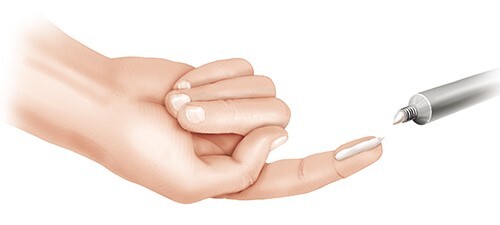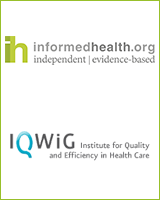NCBI Bookshelf. A service of the National Library of Medicine, National Institutes of Health.
InformedHealth.org [Internet]. Cologne, Germany: Institute for Quality and Efficiency in Health Care (IQWiG); 2006-.
Rosacea can often be treated effectively with topical (externally applied) treatments. If that doesn’t help enough or if the symptoms are severe, other possible treatments include medications that are swallowed. Laser treatment and light therapy can be used for visible blood vessels, and surgery is an option for treating severe rhinophyma (a very bulbous nose).
Rosacea is a common, chronic inflammation of facial skin. The symptoms can vary greatly. Doctors differentiate between four types of rosacea, depending on the main symptoms:
- Type 1: Red areas of skin on the face and sometimes small visible blood vessels
- Type 2: Bumps (papules) and pus-filled spots (pustules)
- Type 3: Thickened and bumpy skin, particularly on the nose (rhinophyma)
- Type 4: Inflamed eyes and eyelids
It is quite common to have a mixture of different types. The treatment is always based on the individual symptoms.
What is effective for treating red skin and small visible blood vessels?
Reddened facial skin can be treated with medication, usually in the form of a gel containing the active ingredient brimonidine. Laser treatment or intense pulsed light therapy can be used for small visible blood vessels. Not all of these treatments have been tested in good-quality studies, though.
Brimonidine
Brimonidine (trade name: Mirvaso) makes the blood vessels narrower, reducing the blood flow to the face and decreasing the redness. But it is not effective in reducing other symptoms of rosacea, such as bumps or pustules.
Brimonidine gel is applied to the skin of the face once a day (for instance, in the morning). It should not be applied to the eyes, lips, mouth or nostrils. Up to 1 gram of the gel should be enough each time you use it. This is about five pea-sized amounts: one for the forehead, one for the chin, one for the nose and one for each cheek. In the first week of treatment, people are advised to use smaller amounts at first and then gradually use more (up to 1 gram) as needed. Once the gel has been absorbed and the skin is dry again, you can use other creams and cosmetics too.
Studies have shown that brimonidine can reduce facial redness: This symptom improved in
- 50 out of 100 people who did not use brimonidine, and
- 76 out of 100 people who used brimonidine.
It usually starts working within one hour, and the effect lasts up to twelve hours.
Possible side effects include skin irritation and allergic reactions in the skin that may make the skin redness even worse. It is important not to get any of the gel in your eyes.
Laser treatment and intense pulsed light therapy
Laser treatment or intense pulsed light therapy are particularly suitable for rosacea with bothersome red blood vessels. Both treatments involve damaging the small blood vessels using heat (also known as cauterizing). But there is hardly any research on these treatment approaches. In Germany, the costs of these treatments aren't covered by statutory health insurers.
Mild pain may occur during and after laser treatment. Cooling the skin can help to reduce the pain. It might also cause superficial skin burns. In addition to pain, this may cause temporary redness, blisters, scabs and swelling. Bleeding at small points on the skin may also occur. But the skin usually heals within a few days. In very rare cases, small scars may remain.
Beta blockers
Facial redness is sometimes treated with beta blockers. This medication causes the blood vessels to become narrower, which lets less blood flow through the skin on the face.
Beta blockers are generally used to treat high blood pressure and other kinds of cardiovascular disease. In Germany, beta blockers are currently not approved for the treatment of rosacea, so they can only be prescribed “off-label”.
Because beta blockers are taken in tablet form, and travel around the body in the bloodstream, they can cause more side effects than creams or gels, which are applied directly to the skin. These side effects include tiredness, dizziness and lightheadedness.
Beta blockers are considered for the treatment of rosacea if the symptoms are severe and no other treatments have helped. But there isn't much research on how effective they are in the treatment of skin redness caused by rosacea. And not everyone is able to take beta blockers. They aren't suitable for people who have asthma, for example, because they could narrow the bronchi in the lungs.
What are the treatment options for red and yellow spots?
Raised spots (papules) and pus-filled spots (pustules) on the skin can be treated with medications that are applied directly to the skin. Creams, gels and lotions containing azelaic acid, ivermectin or metronidazole are normally used.
Several studies have shown that these medications reduce the skin problems or even make them go away completely – at least for a while. A noticeable improvement can be seen after about three to four weeks.
Most people tolerate the medication well. The possible side effects include minor skin irritation, a burning sensation, itching and dry skin.
Azelaic acid
Azelaic acid (trade names: Skinoren, Finacea) reduces inflammation and helps prevent pores from becoming blocked. The gel is carefully applied to the affected areas of skin in the morning and in the evening. Half a gram is used per application. That’s about the amount that is squeezed out of a tube along the last section of an adult’s finger (about 2.5 cm long – see illustration).

1 fingertip unit (1 FTU)
Studies have shown that azelaic acid can noticeably reduce rosacea symptoms: The symptoms improved or disappeared in
- 44 out of 100 people who didn't use azelaic acid, compared to
- 62 out of 100 people who did use it.
Ivermectin
Ivermectin (trade name: Soolantra) reduces inflammation and also fights certain mites that increase the risk of rosacea (Demodex mites). It is applied to the facial skin once a day. A pea-sized amount of the cream is used on each of five areas: the forehead, chin, nose and each of the cheeks. Contact with the eyes, lips and mucous membranes should be avoided. Once the cream has been absorbed by the skin, you can use other creams and cosmetics too.
Ivermectin is used for up to four months. The treatment can be repeated if necessary.
Research has shown that ivermectin can relieve the symptoms of rosacea in many people. They improved considerably in
- 37 out of 100 people who did not use ivermectin, and
- 68 out of 100 people who used ivermectin.
Metronidazole
Metronidazole is an antibiotic drug that reduces inflammation. It is very commonly used in the treatment of rosacea. Metronidazole products are applied to the affected areas of skin once or twice a day in the form of a cream, lotion or gel. It is important to make sure that these medications don't come into contact with your eyes or any mucous membranes. Good sunblock is needed if you go outside because they make the skin more sensitive to sunlight. Tanning beds should be avoided.
A few studies have compared azelaic acid with metronidazole, but they led to contradictory results. So it still isn’t clear whether one is more effective than the other.
Doxycycline
If topical treatments don’t help enough or if the rosacea symptoms are severe, oral medication (to be swallowed) may be considered. The antibiotic drug doxycycline is then typically used.
Doxycycline fights bacteria and also reduces inflammation. When used to treat rosacea, it is often taken at lower doses than when used to treat bacterial infections alone.
Because oral doxycycline enters the bloodstream and travels around the whole body, it causes more side effects than topical treatments do: About 10 out of 100 people have side effects due to doxycycline. The possible side effects include diarrhea, nausea and sensitivity to light.
How can changes affecting your nose (rhinophyma) be treated?
Rosacea sometimes causes the skin on the nose to become thicker, making the nose look large and bulbous (rhinophyma). This mainly happens in men. The skin on the nose may be inflamed too. The treatment that is used will depend on how severe the skin growths are and whether the skin is inflamed.
There is a lack of good research on how best to treat early stages of rhinophyma. Sometimes people try taking isotretinoin capsules over a period of several months. People with rhinophyma often have enlarged oil glands (sebaceous glands) in their skin. Isotretinoin causes these glands to shrink. But there isn't much good-quality research on their effectiveness in treating rhinophyma either.
Isotretinoin may irritate skin and mucous membranes, as well as make them dry and sensitive to light. Blood lipid and liver enzyme levels sometimes increase when using this medication, so they are regularly monitored during the treatment. Women who are pregnant or breastfeeding should not take isotretinoin because it can harm their child. In Germany, isotretinoin has only been approved for use in the treatment of severe forms of acne, so it can only be used “off-label” for rosacea.
Very severe rhinophyma with a swollen and bulbous nose can be operated on or treated with certain laser treatments. These treatments involve numbing the area and removing excess tissue to try to restore the normal shape of the nose. There is a lack of good research here, too.
If the skin on the nose is inflamed, a treatment of several months with an antibiotic like doxycycline may be considered.
What can you do if your eyes are affected?
If rosacea affects your eyes, it's a good idea to see an eye specialist too. In rare cases, deeper layers of the eye may become inflamed.
Blocked sebaceous (oil) glands in the eyelids can be unblocked using warm compresses and gentle massage movements. It is best to ask an eye doctor to show you how.
Depending on the severity of rosacea-related eye problems, doctors may suggest treatment with artificial tears and eye drops containing antibiotics or ciclosporin. Ciclosporin reduces inflammation. If that isn’t enough, treatment with doxycycline tablets may be considered.
Unfortunately there’s a lack of good research on treatments for rosacea-related eye problems, too. So it’s not possible to say which is the most effective.
Sources
- Logger JG, Olydam JI, Driessen RJ. Use of beta-blockers for rosacea-associated facial erythema and flushing: a systematic review and update on proposed mode of action. J Am Acad Dermatol 2020; 83(4): 1088-1097. [PubMed: 32360760]
- Reinholz M, Clanner-Engelshofen B. Rosazea (S2k-Leitlinie). AWMF-Registernr.: 013-065. 2022.
- Van Zuuren EJ. Rosacea. N Engl J Med 2017; 377(18): 1754-1764. [PubMed: 29091565]
- Van Zuuren EJ, Fedorowicz Z, Tan J et al. Interventions for rosacea based on the phenotype approach: an updated systematic review including GRADE assessments. Br J Dermatol 2019; 181(1): 65-79. [PMC free article: PMC6850438] [PubMed: 30585305]
IQWiG health information is written with the aim of helping people understand the advantages and disadvantages of the main treatment options and health care services.
Because IQWiG is a German institute, some of the information provided here is specific to the German health care system. The suitability of any of the described options in an individual case can be determined by talking to a doctor. informedhealth.org can provide support for talks with doctors and other medical professionals, but cannot replace them. We do not offer individual consultations.
Our information is based on the results of good-quality studies. It is written by a team of health care professionals, scientists and editors, and reviewed by external experts. You can find a detailed description of how our health information is produced and updated in our methods.
- Rosacea: Learn More – What are the treatment options for rosacea? - InformedHeal...Rosacea: Learn More – What are the treatment options for rosacea? - InformedHealth.org
Your browsing activity is empty.
Activity recording is turned off.
See more...
